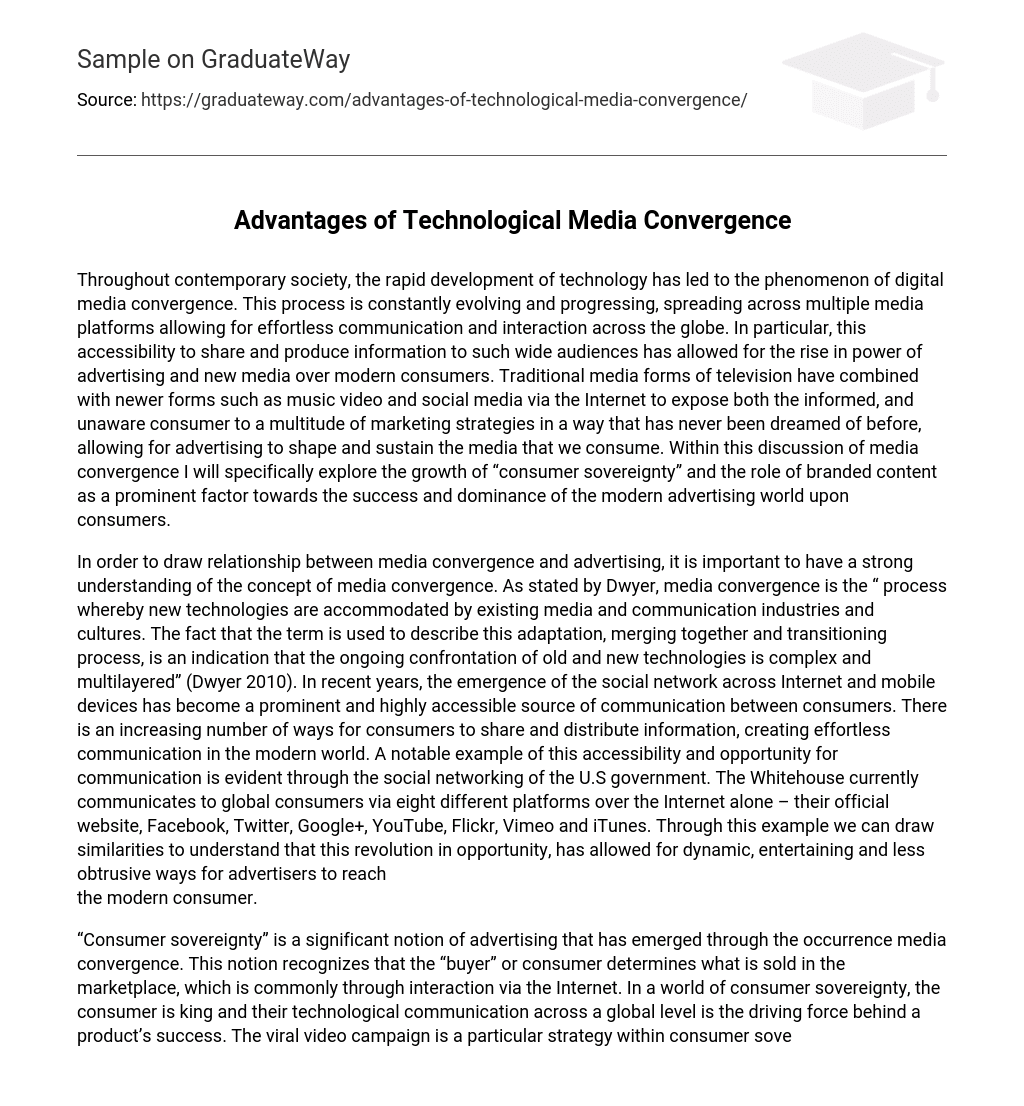The rapid advancement of technology in contemporary society has led to the phenomenon of digital media convergence, which facilitates easy communication and interaction across various global media platforms. Consequently, advertising and new media have gained immense influence over modern consumers due to the accessibility to share and generate information to large audiences. The fusion of traditional forms of media, such as television, with newer forms like music videos and social media through the Internet has resulted in this convergence. This amalgamation exposes both informed and unaware consumers to a variety of marketing strategies that shape and sustain the unprecedented ways we consume media. In this discourse on media convergence, I will examine the rise of “consumer sovereignty” and the crucial role branded content plays in the success and dominance of the advertising industry over consumers.
Understanding the relationship between media convergence and advertising involves grasping the idea of media convergence, which is when existing media industries and cultures adapt to incorporate new technologies (Dwyer, 2010). This process is intricate and multifaceted. With the rise of social networks on the internet and mobile devices, communication has become easier for consumers, offering numerous ways to effortlessly share and distribute information. A noteworthy example is how the U.S government utilizes various online platforms like their official website, Facebook, Twitter, Google+, YouTube, Flickr, Vimeo, and iTunes. This demonstrates the revolution in opportunities that allow advertisers to engage modern consumers through dynamic and entertaining means without being intrusive.
The concept of “consumer sovereignty” has become prominent in advertising due to the emergence of media convergence. This concept recognizes that the consumer, through their interaction on the Internet, determines what is sold in the market. In a world where consumer sovereignty reigns, the consumer holds the power and their global technological communication is the driving force behind a product’s success. One strategy that exemplifies consumer sovereignty is the viral video campaign. Advertisers create humorous and entertaining advertisements that are shared through social networks like Facebook and Twitter. These platforms act as a launch pad, relying on active consumers to share and promote the brand through their interactions with others. Additionally, viral video campaigns reduce marketing costs by eliminating the need for television airtime or targeted internet space. Instead, they rely on the consumer’s popularity and natural interaction to spread brand recognition.
In 2010, Old Spice, the U.S men’s hygiene and grooming brand, launched an incredibly memorable viral video campaign. They utilized YouTube as a platform to release a hilarious and dynamic thirty-second advertisement for their body wash, featuring former NFL player Isaiah Mustafa. This advertisement quickly gained millions of viewers and took the social media world by storm. The sharing and interaction with the brand and video led to instant recognition of Old Spice on a global scale, establishing strong and positive relationships between the advertiser and consumers. According to Morrison (2009), allowing consumer interaction with content fosters creativity and engagement, as individuals create their own stories involving brands. This in turn increases the marketability and global power of the brand.
Implementing viral video campaigns can be both effective and challenging for companies. Advertisers promoting Smartwater with Jennifer Aniston recognized this concept and successfully incorporated popular marketing techniques, including cute animals and dancing babies, to create the ultimate viral video campaign. You can watch the video here.
The Smartwater campaign successfully tackles issues that many brands struggle with: breaking through the monotony of uninspired advertisements and capturing consumer attention. However, not every brand can achieve this level of success. As a result, product placement has emerged as an effective strategy for indirectly marketing products and countering consumer avoidance. With the option to watch television online, viewers can now skip past the excessive advertising seen on modern TV. Product placement involves inserting a branded product into a scene in a TV show or movie (Ho Yu 2006).
Lady Gaga’s music video seamlessly incorporates advertising for multiple brands, such as Virgin Mobile, Plentyoffish.com, and Ray-Ban. Unlike traditional television ads, the video doesn’t overtly highlight these products but rather subtly integrates them. This strategic inclusion of brands by an international pop superstar enhances their appeal to consumers and creates positive associations with the brands. The emergence of social media platforms like YouTube and Facebook due to media convergence also helps in spreading branded content and boosting brand recognition. These music videos can be easily shared on different social networking sites, demonstrating the effectiveness of product placement and giving consumers extensive exposure.
Thanks to technological media convergence and consumer interaction on social media, advertisers now possess a heightened capability to promote products to consumers. Ultimately, this grants them greater authority in the realm of media.
Reference List:
Dwyer, T 2010, Media Convergence, McGraw Hill, Berkshire, pp. 1-23.
The source of the article titled “Ethical Issue of Product Placement and Manipulation” is a book named “In-film Advertising: Brand Positioning Strategy” written by Ho Yu in 2006. The article was viewed on 9th June 2012, and it is available on pages 2 to 14.
Jenkins, H 2006, Convergence Culture, New York, New York University Press, pp 1-24.
In their 2009 article, ‘Beyond Convergence: Confluence Culture and the Role of the Advertising Agency in a Changing World’, Morrison and Sheehan discuss the importance of advertising agencies adjusting to the changing media landscape. They emphasize that in order to effectively connect with their target audience, these agencies must accept and utilize emerging media platforms.
The text “Understanding convergence culture” was viewed on August 30, 2012.





